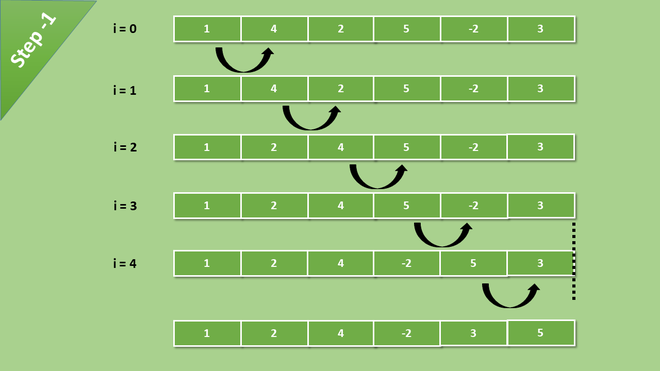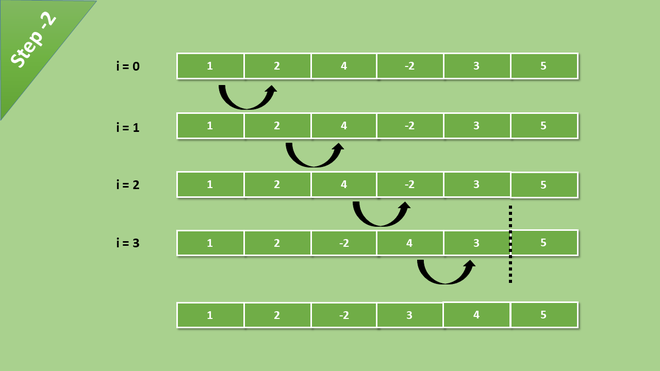El algoritmo de clasificación de burbujas es un algoritmo que clasifica la array comparando dos elementos adyacentes y los intercambia si no están en el orden previsto. Aquí el orden puede ser cualquier orden creciente o decreciente.
Cómo funciona Bubble-sort
Tenemos una array sin ordenar arr = [ 1, 4, 2, 5, -2, 3 ] la tarea es ordenar la array usando la clasificación de burbujas.
La ordenación de burbujas compara el elemento del índice 0 y si el índice 0 es mayor que el índice 1, los valores se intercambian y si el índice 0 es menor que el índice 1, entonces no sucede nada.
luego, el primer índice se compara con el segundo índice, luego el segundo índice se compara con el tercero, y así sucesivamente…
veámoslo con un ejemplo, aquí se ilustra brevemente cada paso

Las comparaciones ocurren hasta el último elemento de la array.
Después de cada iteración, el mayor valor de la array se convierte en el último índice de la array. en cada iteración, la comparación ocurre hasta el último elemento sin ordenar.

Ahora la comparación se redujo un paso porque el elemento más grande está en el lugar correcto



Después de todas las iteraciones y comparaciones de elementos, obtenemos una array ordenada.
Sintaxis
BubbleSort(array){
for i -> 0 to arrayLength
for j -> 0 to (arrayLength - i - 1)
if arr[j] > arr[j + 1]
swap(arr[j], arr[j + 1])
}
Implementación
Javascript
// Bubble sort Implementation using Javascript
// Creating the bblSort function
function bblSort(arr){
for(var i = 0; i < arr.length; i++){
// Last i elements are already in place
for(var j = 0; j < ( arr.length - i -1 ); j++){
// Checking if the item at present iteration
// is greater than the next iteration
if(arr[j] > arr[j+1]){
// If the condition is true then swap them
var temp = arr[j]
arr[j] = arr[j + 1]
arr[j+1] = temp
}
}
}
// Print the sorted array
console.log(arr);
}
// This is our unsorted array
var arr = [234, 43, 55, 63, 5, 6, 235, 547];
// Now pass this array to the bblSort() function
bblSort(arr);
Output Sorted array : [5, 6, 43, 55, 63, 234, 235, 547]
Nota: Esta implementación no está optimizada. Veremos la solución optimizada a continuación.
Solución optimizada
Como discutimos anteriormente, la implementación de la ordenación de burbuja no está optimizada. Incluso si la array está ordenada, el código se ejecutará con una complejidad O (n ^ 2). Veamos cómo implementar un algoritmo de clasificación de burbujas optimizado en javascript.
La sintaxis para la solución optimizada
BubbleSort(array){
for i -> 0 to arrayLength
isSwapped <- false
for j -> 0 to (arrayLength - i - 1)
if arr[j] > arr[j + 1]
swap(arr[j], arr[j + 1])
isSwapped -> true
}
Implementación
Javascript
// Optimized implementation of bubble sort Algorithm
function bubbleSort(arr){
var i, j;
var len = arr.length;
var isSwapped = false;
for(i =0; i < len; i++){
isSwapped = false;
for(j = 0; j < len; j++){
if(arr[j] > arr[j + 1]){
var temp = arr[j]
arr[j] = arr[j+1];
arr[j+1] = temp;
isSwapped = true;
}
}
// IF no two elements were swapped by inner loop, then break
if(!isSwapped){
break;
}
}
// Print the array
console.log(arr)
}
var arr = [243, 45, 23, 356, 3, 5346, 35, 5];
// calling the bubbleSort Function
bubbleSort(arr)
Output Sorted Array : [3, 5, 23, 35, 45, 243, 356, 5346]
Complejidades
Peor caso y complejidad de tiempo de caso promedio
Si la array está en orden inverso, esta condición es el peor de los casos y su complejidad temporal es O(n 2 ).
Complejidad de tiempo en el mejor de los casos
Si la array ya está ordenada, entonces es el mejor de los casos y su complejidad de tiempo es O (n)
Espacio Auxiliar : O(1)
Publicación traducida automáticamente
Artículo escrito por _saurabh_jaiswal y traducido por Barcelona Geeks. The original can be accessed here. Licence: CCBY-SA